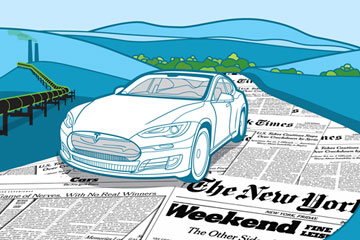
Elon Musk, the billionaire entrepreneur, gave us SpaceX rockets and the Tesla battery-powered roadster. His latest innovation is a project that has long been as elusive to certain companies as private spaceflight or the electric car: a way to hit back at scathing reviews on equal footing.
On Feb. 10 the New York Times published a review by John M. Broder, who drove Tesla's Model S sedan from Washington, D.C., to Connecticut. It was a bad trip for all involved. After a fine start, in which Broder admired the Tesla as a "technological wonder," he noted that the car's dashboard estimate of range was shrinking faster than he was putting miles on the odometer. Parked overnight in frigid weather, the battery lost much of its remaining range. His drive back to a charging station ended with the shut-down car on the back of a flatbed truck.
Once, Tesla would have had to take its lumps and maybe pitch a more favorable story to a rival paper. But the day after the review, Musk claimed on Twitter that Broder's review was "fake," and a chart-and-graph-filled post on Tesla's blog two days later purported to prove just that.
Among the indictments, gathered from data monitoring on the test car: that Broder undercharged the battery, claimed to have set the cruise control to 54 m.p.h. to save energy but didn't and cranked up the heat as the charge faded. Musk accused Broder of working "very hard to force our car to stop running," maybe because of "his outright disdain for electric cars." (One pictures the Times saboteur cursing behind the wheel: "Damn you, Model S! Why won't you die?")
Tesla fans rose up in outrage, and the Times went on the defensive. Broder responded on a Times blog that some of Musk's data "rebutted" things he never wrote and that he operated the car according to instructions from Tesla tech support. Broder's response generated over 700 comments, one charging that the review was "paid for by your friendly oil companies." Margaret Sullivan, the Times' public editor (an ombudsman-like post), looked into the ruckus and judged that Broder drove the car "in good faith." But: "Did he use good judgment along the way? Not especially."
So it was not the Jayson Blair--like scandal that Musk made it out to be, but Tesla's image was liberated from the flatbed. By the next week, spurred by the publicity, other news outlets and Tesla owners were driving Broder's route, sans breakdowns and with much praise for the car.
The outcome may suggest a new approach for how embattled companies deal with bad press. Musk's counterattack sounded less like standard corporate-crisis p.r. and more like aggressive political rapid response. Instead of polite objections, you had quick pushback, charges of bad faith and bias and the marshaling of a fervent base. Musk sidestepped the mainstream media to argue directly to the public--as the Obama Administration lately has, to the consternation of outlets like the Times.
